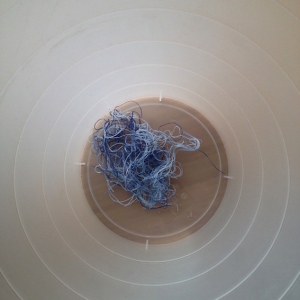14
2015Zero waste: why fully fashioned knitwear is ecologically justified
The fashion industry is the second most polluting industry in the world. Think of the immense amounts of water necessary for the cultivation of cotton, oil as raw material for synthetic textiles, chemicals to improve characteristics of textiles, dyeing chemicals, machineries, wrapping and transport.
The production of a simple t-shirt affects most of the above mentioned parts of the chain. Regarding the huge quantities of fashion articles we annually buy (as well as an equal amount of (scarcely) used items we discard), every improvement somewhere in the chain contributes to a less polluting fashion industry. But today I want to talk about waste.
As raw materials (fresh water, raw oil) are scarce, semi-finished products (fabric, yarn) are likewise precious. Every bit of yarn, every bit of textile has gone through a lot of treatments, some for which chemicals are used, some for which water is used, some for which electricity is used and often all three of them. So you can count your blessings when you manage to reduce waste in the production stage. And then, I haven’t mentioned yet that our world must see to get rid of all things we consider waste. Waste processing is subject to another story!
My most recent work is the tailor made dress MOON. While working on this dress it suddenly struck me that all I had to throw away were a few cut off yarn remnants. I had just emptied my dustbin so I could exactly see how next to nothing it was. I proudly present you the contents of my dustbin.
While working on this dress it suddenly struck me that all I had to throw away were a few cut off yarn remnants. I had just emptied my dustbin so I could exactly see how next to nothing it was. I proudly present you the contents of my dustbin.
I used to sew a lot and I recall to have produced a lot more waste: tiny and not so tiny pieces of fabric, fusible interfacing, wrappings of buttons and zippers, pattern drawing paper, sewing yarn, broken needles, rusty pins, etcetera. Now I hate full dustbins so I switched to knitting ;-)
With the knitting machine I make everything fully fashioned, directly in the right size and form that is to say. So in the end I have no cutaways. All untouched yarn is still on cones waiting to be used in one of my next projects.
However, there are machine knitters who produce mere jersey fabric. Subsequently they pick up a pair of scissors to cut out the pattern pieces and then sew them together with a lock machine. To be honest with you: I wouldn’t have the nerve to put my scissors into a carefully knitted piece of jersey. And what’s more I don’t like the seams you get with the machine. I use my linker for that. And that is another small, but nevertheless significant detail, ecologically speaking, of my fashion manufacture: neither the knitting machine nor the linker use electricity.
For your information: MOON was made with 50% mercerized cotton yarn and 50% GOTS* certified organic cotton yarn.
* GOTS stands for Global Organic Textile Standard. It covers the whole production chain and provides rules for ecological and socially responsible textile production.